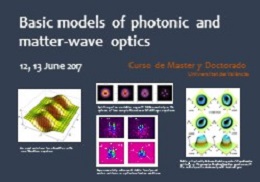
On June 12 and 13, the course 'Basic models of photonic and matter-wave optics', included in the training activities' program for Master and PhD students, will be held at the Optics Department of the University of Valencia. Dr. Boris Malomed will be the professor in charge of the course. More information:
Fechas: 12, 13 de junio, de 16 a 18 horas.
Lugar: Seminario del Dep. de Óptica y Optometría y Ciencias de la Visión.
Edificio D de la Facultad de Física. Planta baja.
Profesor: Boris A. Malomed, Dept. of Physical Electronics, Faculty of Engineering, Tel Aviv University, Israel.
Sesión 1 -Día 12- : Fundamental nonlinear equations in physics, and their fundamental solutions
Sesión 2 -Día 13- : Solitons and solitary vortices in continuous and discrete two-dimensional models
Material: (Presentation's slides) Sesion1 slides ; Sesion2 slides
Abstracts:
Fundamental nonlinear equations in physics, and their fundamental solutions (Boris A. Malomed):
A brief overview of universal equations, which govern the propagation of non linear waves in various physical media (both classical - such as optical fibers - and macroscopic quantum media, such as Bose-Einsten condensates, BECs), will be given. The survey will include the non linear Schroedinger (NLS)/Gross-Pitaevskii equations, the sine-Gordon (SG) equation, the Korteweg - de Vries (KdV) equation, the Kadomtsev - Petviashvili (KP) equations, and some others (the KP equations are two-dimensional models). All the above-mentioned equations, in their ideal form, share the fascinating property of the exact integrability, by means of a mathematical technique known as "the inverse-scattering transform". Not only are these equations ubiquitous and universal, but also their fundamental solutions - first of all, solitons, i.e., solitary waves - play a profoundly important role in all physical settings to which the model equations apply. In the case when the model contains additional terms breaking the exact integrability, and efficient perturbation theory for solitons may be developed, predicting many non-trivial effects which are not possible in the integrable systems. Solitons have been predicted in a great variety of physical systems, and one-dimensional solitons were observed and/or created experimentally in nonlinear optics, BEC, long Josephson junctions superconductivity), fluid flows, plasmas and many other settings. A great challenge to the experiment is to produce stable two- and three-dimensional solitons, which have been predicted by a more recent theoretical analysis.
Solitons and solitary vortices in continuous and discrete two-dimensional models (Boris A. Malomed):
The objective of the extended talk is to present an overview of the description of fundamental dynamical models for the pattern formation in nonlinear two-dimensional (2D) media. The overview includes fundamental models and their basic solutions for solitary patterns (2D solitons). Both conservative and dissipative models will be reviewed. The presentation includes four parts, defined according to basic mechanisms which provide for the stability of the 2D solitons, as the stability is the main issue in this field:
(A) Conservative systems with trapping potentials;
(B) Conservative systems with the cubic-quintic (CQ) nonlinearity;
(C) Dissipative models based on 2D complex Ginzburg-Landau (CGL) equations;
(D) Stable 2D composite solitons in spin-orbit-coupled self-attractive Bose-Einstein condensates in free space.









